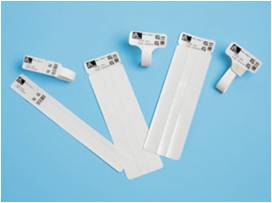 You’ve decided to deploy barcoded patient wristbands, but what wristband materials and what printing options should you select? Zebra Technologies’ recent white paper, It’s All in the Wrist: Improving Patient Safety with Barcode Wristbands, provides valuable insight into the competing considerations that will drive those decisions.
You’ve decided to deploy barcoded patient wristbands, but what wristband materials and what printing options should you select? Zebra Technologies’ recent white paper, It’s All in the Wrist: Improving Patient Safety with Barcode Wristbands, provides valuable insight into the competing considerations that will drive those decisions.
Wristband Materials
 First and foremost, the wristband you deploy must be durable enough and secure enough to stay with the patient. As Zebra notes, the most common patient wristband error is that the wristband is missing entirely, with various studies finding incidents of hospital patients missing wristbands ranging from 2 to 10 %t. Patient wristbands are, by definition, deployed near the most active parts of the human anatomy – our hands – so must be expected to endure constant motion, abrasion and exposure to mechanical challenges. Plus, they must also be sufficiently lightweight and comfortable that the patients themselves will not be tempted to remove them.
First and foremost, the wristband you deploy must be durable enough and secure enough to stay with the patient. As Zebra notes, the most common patient wristband error is that the wristband is missing entirely, with various studies finding incidents of hospital patients missing wristbands ranging from 2 to 10 %t. Patient wristbands are, by definition, deployed near the most active parts of the human anatomy – our hands – so must be expected to endure constant motion, abrasion and exposure to mechanical challenges. Plus, they must also be sufficiently lightweight and comfortable that the patients themselves will not be tempted to remove them.
Material and format considerations include:
- Method of fastening: Should the fastening method be tamper proof or resistant; must evidence of tampering be apparent; should the wristband be resizable?
- Printing method: Will the wristband be applied using laser or using thermal printing methods?
- Reapplication: Will the wristband require occasional removal and reapplication?
- Longevity: Will the wristband remain fully functional beyond the foreseeable length of the patient’s stay?
- Ease of Deployment: Will implementation of the wristband material and format be prohibitively time-consuming?
- Training: Will the material and format option require special training of healthcare and administrative personnel?
Printing Options
Although bar-coded wristbands may be printed using either laser or thermal printers, dedicated thermal printers offer far greater efficiency as well as material and format options. On the other hand, laser  printers are likely to already be in service in all areas of the healthcare facility where patient wristbands will be printed. In most cases, though, the upfront cost advantages of using laser printers that are already in service are unlikely to outweigh the numerous long-term advantages of deploying dedicated thermal wristband printers. Fortunately, Zebra offers patient-wristband options that answer each of these considerations.
printers are likely to already be in service in all areas of the healthcare facility where patient wristbands will be printed. In most cases, though, the upfront cost advantages of using laser printers that are already in service are unlikely to outweigh the numerous long-term advantages of deploying dedicated thermal wristband printers. Fortunately, Zebra offers patient-wristband options that answer each of these considerations.
Zebra’s patented self-laminating LaserBand wristbands resist abrasion, moisture and hand-sanitizers and yet can be printed using laser printers already in service in the facility. This solution facilitates simultaneous printing of chart labels and wristbands on a single sheet, maximizing efficiency of the admission procedure.
But, Zebra’s thermal-print Z-Band wristbands offer efficiency advantages of their own, while providing optimal print quality and longevity. For example, with its HC100 Patient-ID system, the user simply selects the cartridge that contains the desired wristband style and pops it into the printer. Wristband size and print calibration are automatically executed by the printer. Plus, the HC100’s small footprint allows it to be positioned where most convenient for the user – even on mobile workstations.













